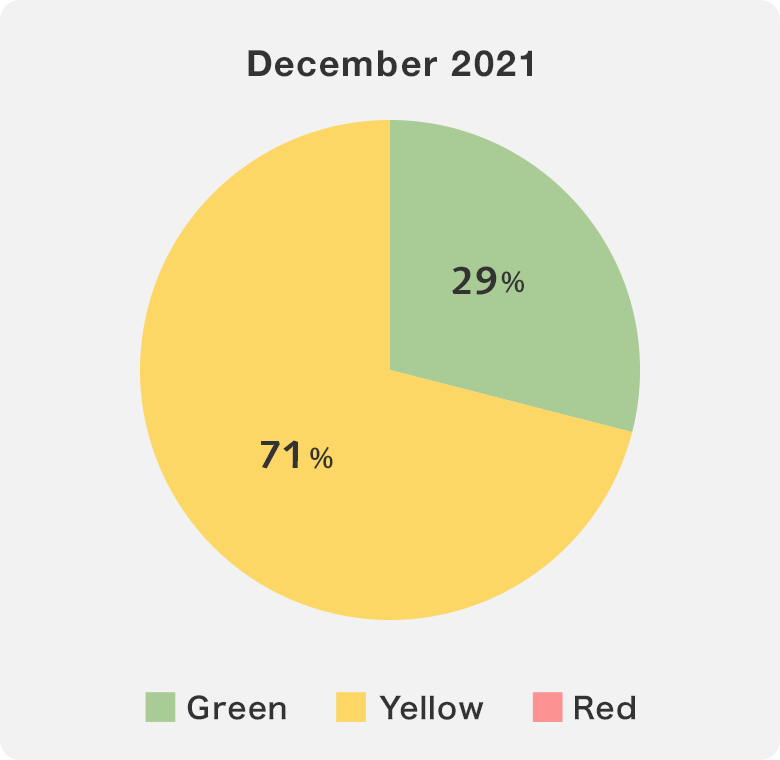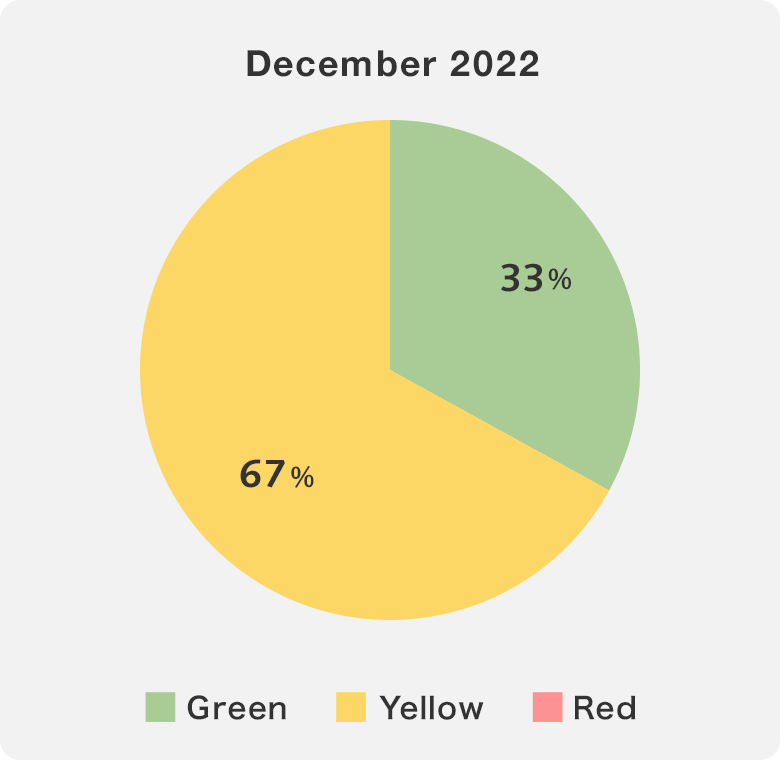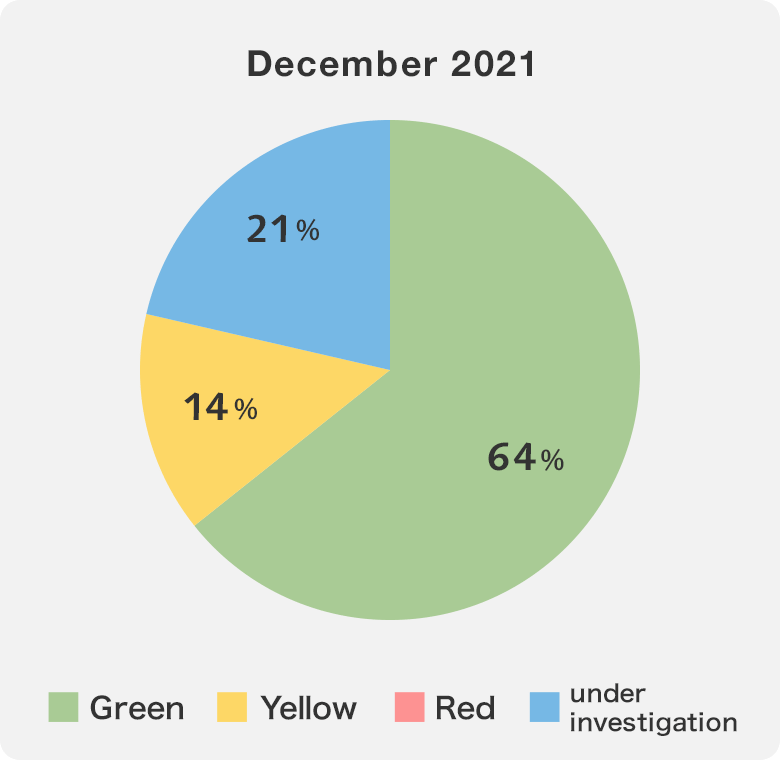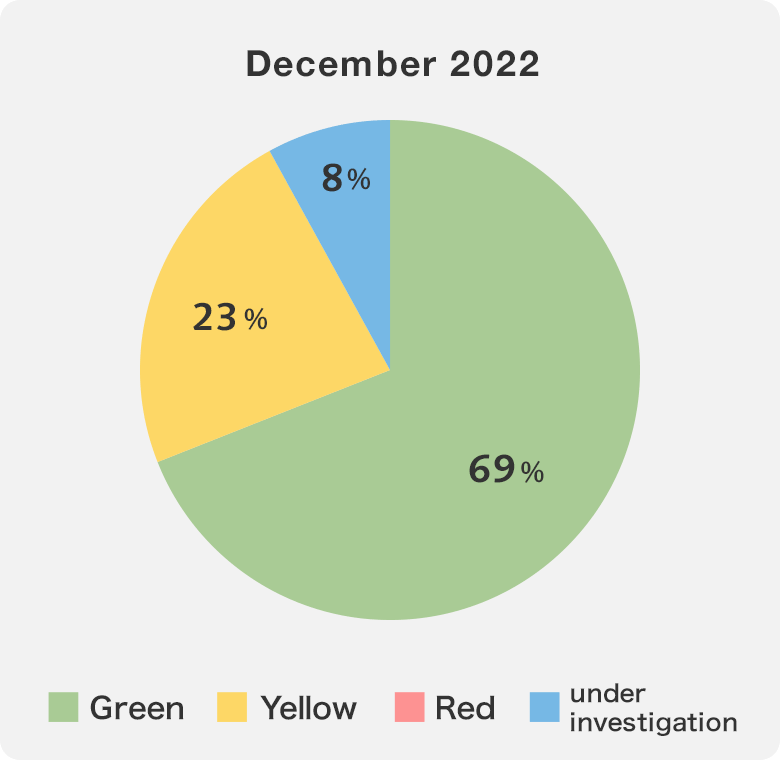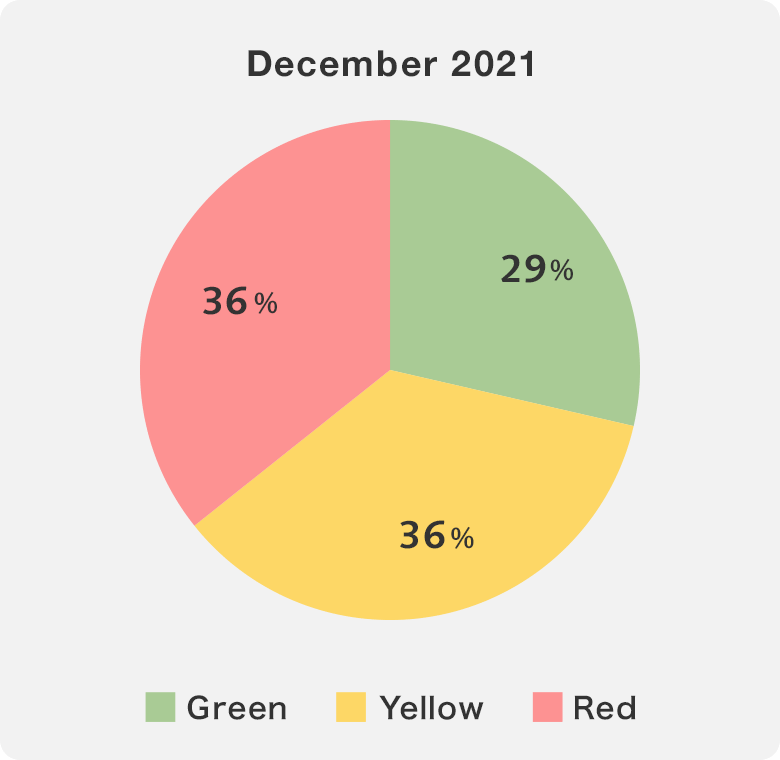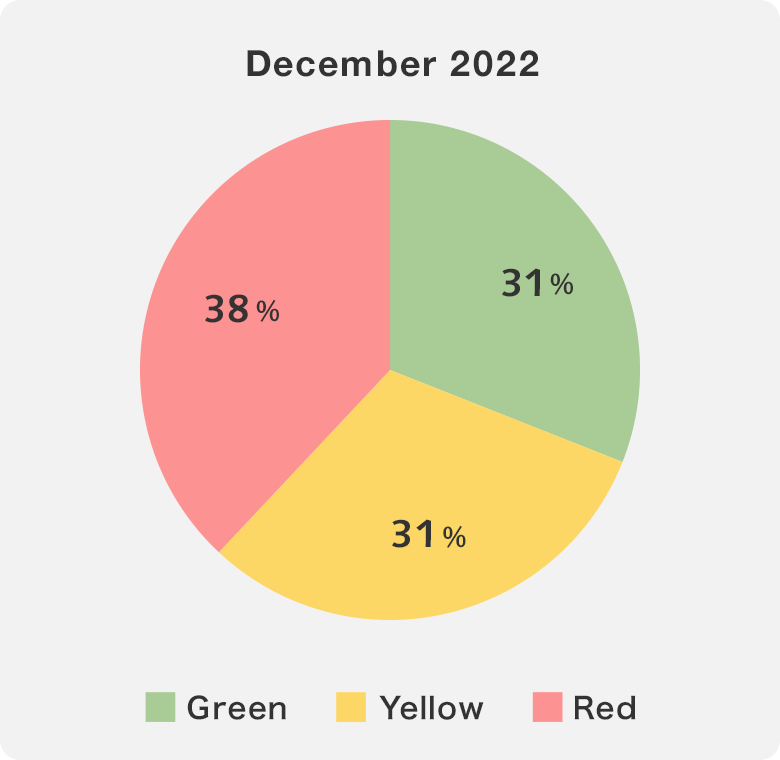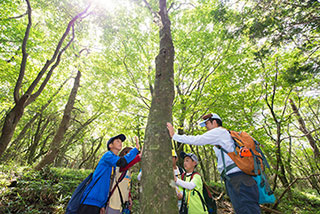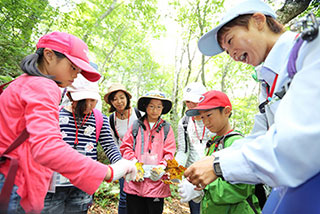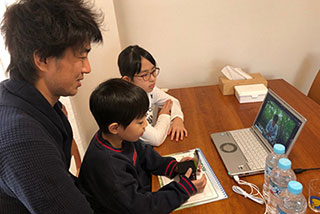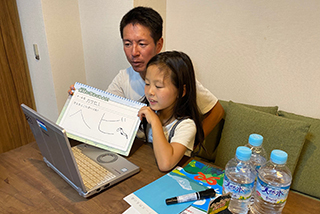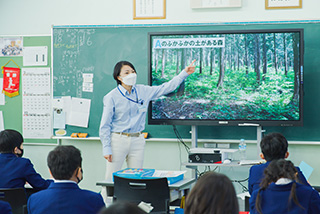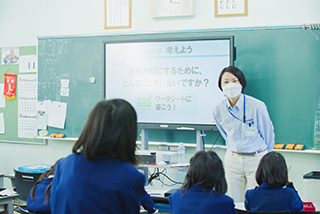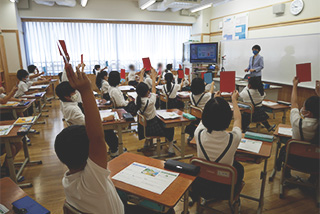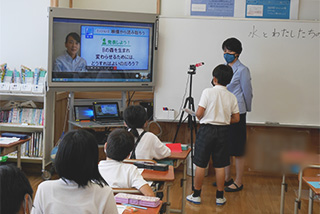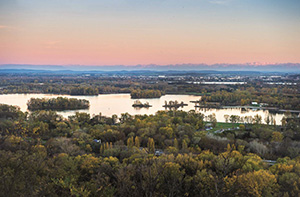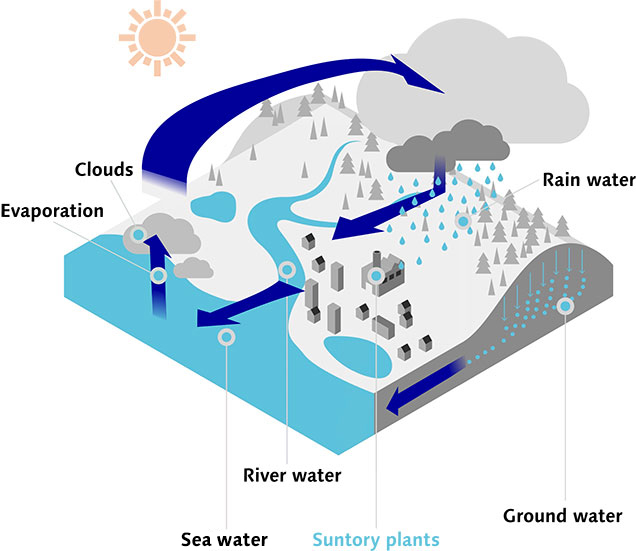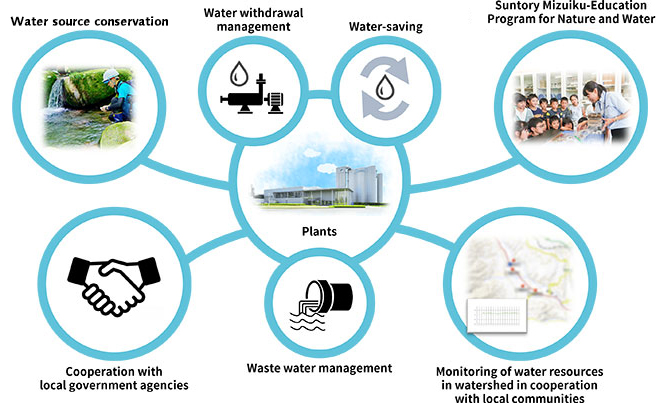Water & CO2
- Sustainable Water Philosophy
- Water Sustainability
- Enhanced 3Rs for Water to Reduce Water Use
- Water Risk Assessment
- Natural Water Sanctuaries (Water Resource Cultivation/ Preserving Biodiversity)
- Bird Conservation Activities
- Suntory Mizuiku - Education Program for Nature and Water
- Water Initiatives Worldwide
- Endorsing The CEO Water Mandate
- Achieving the AWS Certification for Water Stewardship
Sustainable Water Philosophy
Our craftsmanship is only possible through nature’s gifts. It is our duty to nurture and protect water as an invaluable natural resource. Everything we create is grounded in respect and appreciation for water and we are committed to our efforts to keep water in its purest and most abundant form for future generations.
Sustainable Water Philosophy Overview
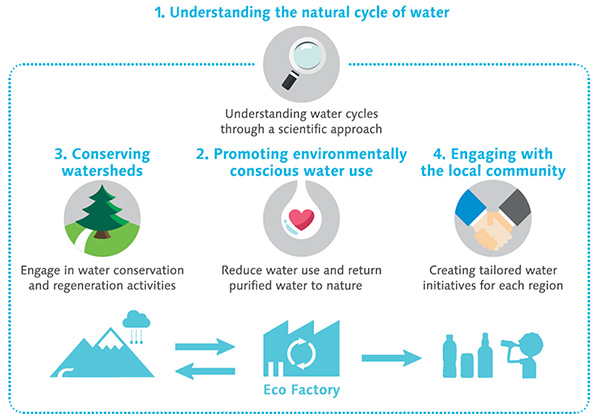
Establishing Our Sustainable Water Philosophy
SBF follows the Suntory Group Sustainable Water Philosophy established to address relevant water issues in each of your regions of operation. As we grow internationally, we are expanding our work on water sustainability across the globe.
Suntory Group’s Sustainable Water Philosophy(Established 2017)
Water is the most important ingredient of our products, as well as a precious shared resource. In order to achieve "water sustainability", the first pillar of Suntory Group's Environmental Policy, we want to share these values with all Suntory Group members and apply them where we operate in order to answer to our stakeholders' expectations.
- Understanding the natural cycle of water
We investigate watersheds around our sites to understand the local hydrological cycle, using a scientific approach when needed. - Promoting environmentally conscious water use
We reduce the environmental impacts of water use on the natural water cycle by implementing 3R activities and returning water to nature after adequate treatment. - Conserving watersheds
We conserve our watersheds and endeavor to improve local water quality and quantity in cooperation with stakeholders for a sustainable future. - Engaging with the local community
We endeavor to support our community by fostering collective actions to solve water issues and enrich society.
Water Sustainability
Only about 0.01% of the entire fresh water on Earth can be used by mankind. Suntory Group business is supported by precious global resources such as water and agricultural products. Suntory Group uses water carefully and not only returns clean water to nature, but protects forests that nurture groundwater and contribute to healthy circulation of water in nature. In other words, we recognize that water sustainability is the most important issue in our business activity.
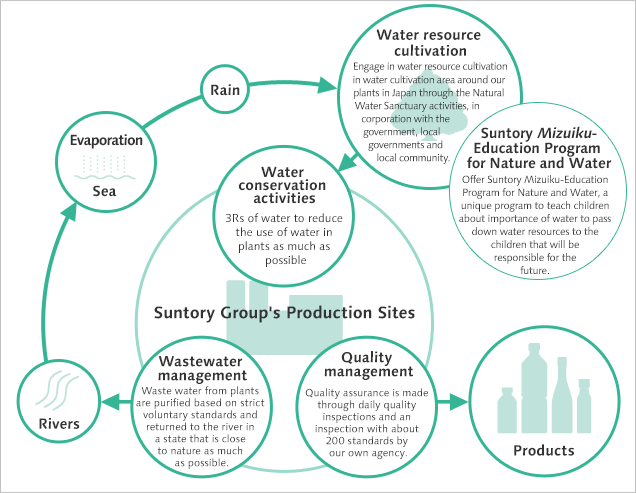
Realizing Preservation and Regeneration of Natural Environment
The Suntory Group businesses are supported and realized by precious global resources such as water. We are reducing the environmental burden in our business activities to pass down a global environment rich with water and abundant nature to the future generations. We are also promoting activities that contribute to the preservation and revitalization of the natural environment such as the preservation of the natural environment in Natural Water Sanctuaries, Save the Birds activities to share the importance of protecting the wild birds that symbolize a rich ecosystem with society, and the Suntory Mizuiku - Education Program for Nature and Water that communicates the importance of water to children.
Within our Environmental Vision 2050, we declare an ambition to take on the challenge of actively engaging in environmental preservation and restoration activities in the main countries of operation, while also setting various targets for them in the Environmental Targets toward 2030
Enhanced 3Rs for Water to Reduce Water Use
Suntory Group’s plants use a large amount of water, for example, in cleaning production equipment and cooling, in addition to using it as an ingredient in our products. In order to conserve limited water resources, we intensify our activities to achieve targets toward 2030 of "Reduce water consumption at Suntory Group plants worldwide by 35%*1" through enforcement of 3Rs for water, ensuring that the minimum amount of water is required (Reduce), water can be used repeatedly (Reuse), and water can be processed and used elsewhere (Recycle).
-
*1Reduction per unit production based on the business fields in 2015
Applying 3Rs in Water Usage
When selecting equipment and devices in our plants, we follow the "3Rs of Water": Reduce the amount of water as much as possible, Reuse water, and Recycle water through treatment.
A variety of activities related to the 3Rs are being implemented at the Minami Alps Hakushu Water Plant of Suntory Products. In particular, thanks to our use of a sophisticated "water cascade" recycling process, we are an industry leader in terms of per unit production in relation to the volume of water used.
-
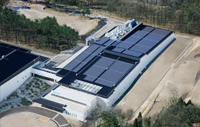
The Minami Alps Hakushu Water Plant of Suntory Products
-
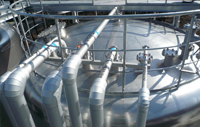
Reuse of water recycled at each stage of cleaning stored in 200 ton tanks
Using Cascades of Water
Water used in the manufacturing process is classified into five grades, including coolant water, cleaning water, ets., based on quality. This technology allows plants to recycle water to be used in subsequent processes, for example, using the highest grade water in the most demanding process, and recycling it for use in a process with less stringent requirements.
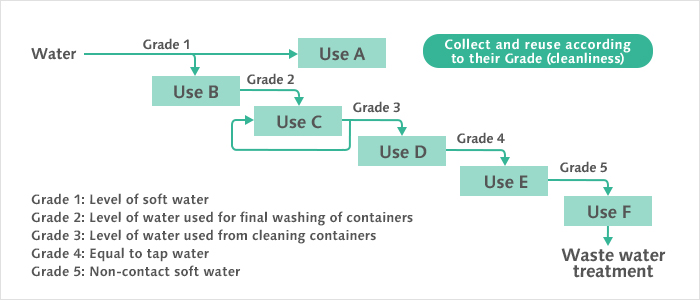
Water Risk Assessment
The Suntory Group, which has made achieving water security a vital issue in Suntory Group's Environmental Principles, continues to conduct various water-related assessments at the Institute for Water Science, established in 2003. We conduct water-related risk assessments for sustainable business activities and use these assessments to promote environmental management. We also consider water risk assessment when developing new businesses.
Water Risk Assessment of Suntory Group’s Direct Operation sites
Water is the most vital ingredient for our business, as well as a precious shared resource. As such, the Suntory Group must understand the impact on our business, local communities, and the ecosystem based on water risk assessment for sustainable business growth.
Based on this, the Suntory Group conducted a risk assessment of water sustainability at direct operation sites*.
* Suntory Beverage & Food Group plants that manufacture finished products: 10 plants in Japan, 31 plants overseas
1. Water stress situation at Suntory Beverage & Food in countries where direct operation sites are located
We identified the water stress situation in countries where direct operation sites are located using Baseline Water Stress, an indicator in the Aqueduct Country Ranking developed by the World Resources Institute. The Aqueduct Country Ranking is a global tool for uniformly assessing the water risk of each country.
| Baseline Water Stress | |
|---|---|
| Extremely high | – |
| High | Spain |
| Medium-high | France, Thailand, Indonesia |
| Low-medium | Japan, USA, UK |
| Low | Taiwan, Vietnam, Malaysia, New Zealand |
Based on country scores for Baseline Water Stress as used in Aqueduct by World Resources Institute.
2. Water risk assessment at Suntory Beverage & Food in watersheds where direct operation sites are located
In addition to assessing the water stress situation in countries where direct operation sites are located, we prioritized the area by determining the water supply risk of all watersheds where they are in to manage the risks. The following is the assessment process and progress of risk management.
Primary Assessment — Prioritization (Screening) of sites based on water stress assessment
The primary assessment was conducted using a method we developed based on the knowledge acquired during the Science Based Targets (SBT) for Water pilot study program* in which we participated in 2021.
As a first step, we identified materiality related to water based on the characteristics of the beverage industry. Through this, we found that the most critical materiality is the water availability in watersheds where direct operation sites are located. We also found that groundwater and surface water are the ecosystem services we depend on most.
Next, we assessed the risks related to water availability in all watersheds where our sites are located to narrow down the plants that need water risk management as a priority. For assessment, in addition to the indicator of the Aqueduct mentioned earlier, we also referred to the Water Risk Filter developed by World Wide Fund for Nature (WWF). From those tools, we adopted four indicators that we can use to assess risks related to water availability. These indicators were used to determine the water availability based on the ratio between the amount of water supplied to the watershed by precipitation and the amount of water demand in the watershed, estimated based on population statistics. Three of the four indicators assessed "current" water stress levels, such as Water Depletion in the Water Risk Filter. We defined the average score of three indices as the current water risk score. For the remaining indicator, we adopted the 2040 Water Stress of the Aqueduct, which estimates the water availability in 2040 based on climate change scenarios ,etc., as "future" water risk score. All indices are scored in five risk levels and we categorized sites in watersheds with average current water risk score of "5: Extremely High" and "4: High" as sites with "Extremely high water-stressed" and sites with future water risk score of four or above as sites with "Highly water-stressed."
At Suntory Beverage & Food, supposing the total water withdrawal by all our plants in 2021 as 100%, 3% were by sites with "Extremely high water-stressed," and 19% were by sites with "Highly water-stressed." In the secondary assessment, we have set 22% of the plants as priority plants to prioritize in risk reduction.
* Pilot study to verify methodology related to SBT settings for water by Science Based Targets Network
-
Water Depletion of Water
Risk Filter (Five Levels)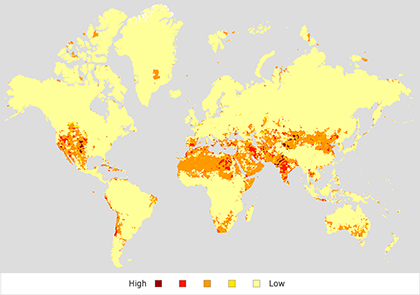
Source: Created based on Water Risk
Filter of World Wide Fund for Nature (WWF) -
A2040 Water Stress BAU
Scenario of Aqueduct (Five Levels)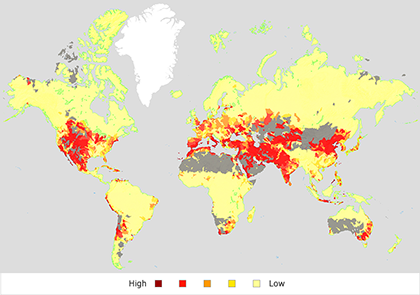
Source: Created based on Aqueduct
Project of World Resources Institute
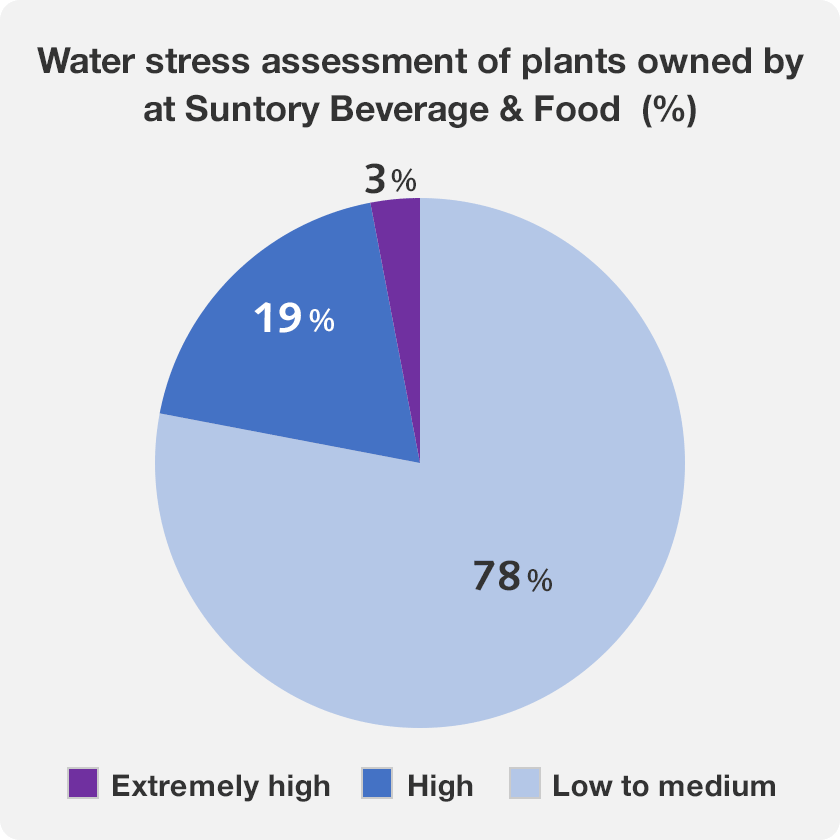
Secondary assessment — Assessing the level of risk reduction measures at each plant
The level of risk reduction measures progress from the perspective of water management (water withdrawal and water-saving) and coexistence with the communities at sites narrowed down in the primary assessment as we assessed priority plants. Since the condition of the water resource is different in each watershed where our sites are located, we conduct measures to reduce risks that correspond with local conditions.
a. Water management (Water withdrawal and water-saving management)
As water is a precious resource shared with the community and ecosystem, our plants must manage water in a responsibly and appropriately.
Our plants water sources fall into two main categories: municipal and natural water (surface water and/or groundwater). Since municipal water is generally shared with various users in the community, its source area is extensive, and the local water authorities are the primary entity responsible for managing water withdrawal from the source. The plant needs to follow the water supply management policies and plans of the water authorities, including climate change adaptation plans, and promote appropriate water-saving management. On the other hand, if a plant uses natural water as a source, the primary entity responsible for managing water withdrawal is the plant, which has water intake inside the site. Therefore, the plant needs to take the initiative in water withdrawal and water-saving management to adapt to environmental changes such as climate change.
Based on the above points, we have assessed the level of measures progress to manage water withdrawal and water-saving at each plant. We evaluated the following two items:
(1) Water withdrawal management
The ability to prove that water withdrawal is managed properly (that water is not excessively withdrawn)
* Plants that use municipal water are not covered as the water authorities manage the water withdrawal
<Assessment criteria>
- The ability to collect the required water withdrawal data to demonstrate that water withdrawals are not significantly impacting local river and groundwater levels.
- Required water withdrawal data is being collected.
| Required water withdrawal data is not collected | → | Red |
|---|---|---|
| Part of the required water withdrawal data is collected | → | Yellow |
| All required water withdrawal data is collected, and water withdrawal is appropriately managed | → | Green |
<Assessment Results>
The following is water withdrawal management level of each plant represented as a pie chart. As a result of corrective actions taken at plants with assessed as having insufficient measures of progress, the percentage of plants at Suntory Beverage & Food whose progress level is Green has changed from 29% (December 2021) to 33% (December 2022).
(2) Water Saving Management
The ability to demonstrate that the progress of water saving activities is adequately managed
<Assessment criteria>
- Target was established to promote efficient use of water.
- Conducting activities to achieve the target yearly.
- Target is achieved yearly.
| No med-term target for water intensity | → | Red |
|---|---|---|
| No yearly target for water intensity or not achieved | → | Yellow |
| The yearly target for water intensity has achieved | → | Green |
<Assessment Results>
The following is the water-saving management level of each plant represented as a pie chart. As a result of setting a medium-term target and conducting water-saving measures to achieve the yearly target, the percentage of plants at Suntory Beverage & Food that have the water-saving management level of Green increased from 64% (December 2021) to 69% (December 2022).
We will continue to conduct measures to reduce risks using this process.
b. Coexistence with the community
As we are users of water as a shared resource with the community, Suntory recognizes part of the many stakeholders in the watershed; we aim to contribute to the development of the watershed society by conserving the water resource in each watershed to work hand-in-hand with the other stakeholders.
Precisely, following the roadmap for water source conservation efforts in the Environmental Targets toward 2030, we are identifying water-related issues in the watershed where our sites are located with local stakeholders. With the agreement of major stakeholders, we then begin conducting measures to conserve the water source area upstream of the site.
Based on the above points, we have assessed the progress of measures to co-exist with the community at each plant.
<Assessment criteria>
- Have identified issues related to ensuring water sustainability in the watershed.
- Have worked with local stakeholders to implement measures that contribute to resolving the issues.
| Water-related issues in the watershed are not identified | → | Red |
|---|---|---|
| Water-related issues in the watershed are identified | → | Yellow |
| Working with the community to resolve water-related issues in the watershed | → | Green |
<Assessment Results>
The following is the progress of measures related to coexisting with the local community at each plant, represented as a pie chart. As a result of steady efforts at each plant, 31% of the plants at Suntory Beverage & Food reached the level of Green (December 2022).
In each area, we identify water-related issues and progress water source conservation efforts with experts such as university professors. At the Toledo Plant in Spain, we collaborate with a local NGO and a university in researching the ecosystem and conducting hydrological surveys to improve the water quality of the Tagus River basin through a project called "Guardians of the Tagus." We are running a more detailed field survey of the upstream of a municipal water reservoir used by the plant, which is identified as the recharge area, to make a plan for conservation activities. Furthermore, at the Bogor Plant in Indonesia, we have identified the recharge area of the groundwater aquifer our plant use based on the hydrological survey of the watershed about river flow rates considering the rainy and dry seasons, water quality, and geological structure in cooperation with a local university in preparation for formulating a plan for groundwater conservation. The survey is to identify the hydrologic cycle of the water recharge area objecting to reduce risks regarding water cycle. We spent 4.7 million Japanese yen on this survey. We will continue to follow the roadmap toward 2030 for water source conservation efforts and steadily conduct those activities.
We will also conduct "Mizuiku" - Education Program for Nature and Water at areas we perform these activities to teach the importance of conserving the water source to the local children who will lead the next generation.
Natural Water Sanctuaries
(Water Resource Cultivation/ Preserving Biodiversity)
Natural Water Sanctuary Initiative -- For the future of water and life
Suntory is a "water" company.
Without quality water, we are unable to produce any beer, soft drinks, or whisky.
This is because water, especially groundwater, serves as Suntory's lifeline.
This precious groundwater is nurtured in the forest.
In order to maintain safety and reliability of groundwater as well as sustainability, we are cultivating water resources in forests which is more than twice the amount of water withdrawn by our plants. Therefore, plant water source recharge areas are specified, with a focus on our Institute for Water Science, and mid-to-long-term agreements are established with local government and forest owners to maintain forests, leading to the establishment of Natural Water Sanctuaries.
In addition to the first sanctuary location established in Aso City, Kumamoto Prefecture in 2003 and the newest sanctuary called "Natural Water Sanctuary Northern Alps" (located in Omachi City, Nagano Prefecture) in March 2019, there are 22 Suntory Natural Water Sanctuaries in 15 prefectures which comprise a total area of approximately 12,000ha.
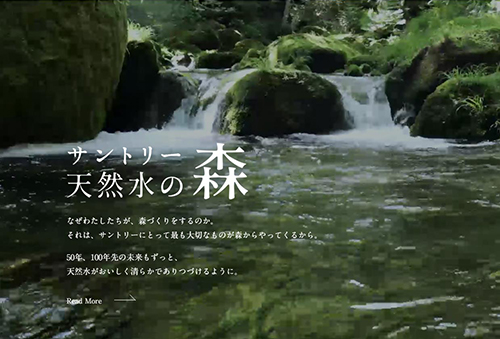
<Natural Water Sanctuary> Development Targets
- Forests with a great capacity for cultivating water resources
- Forests rich in biodiversity
- Forests able to withstand flooding and landslides
- Forests with great CO2 absorption capabilities
- Beautiful forests where visitors can encounter nature in all its abundance
(used for education programs, etc.)
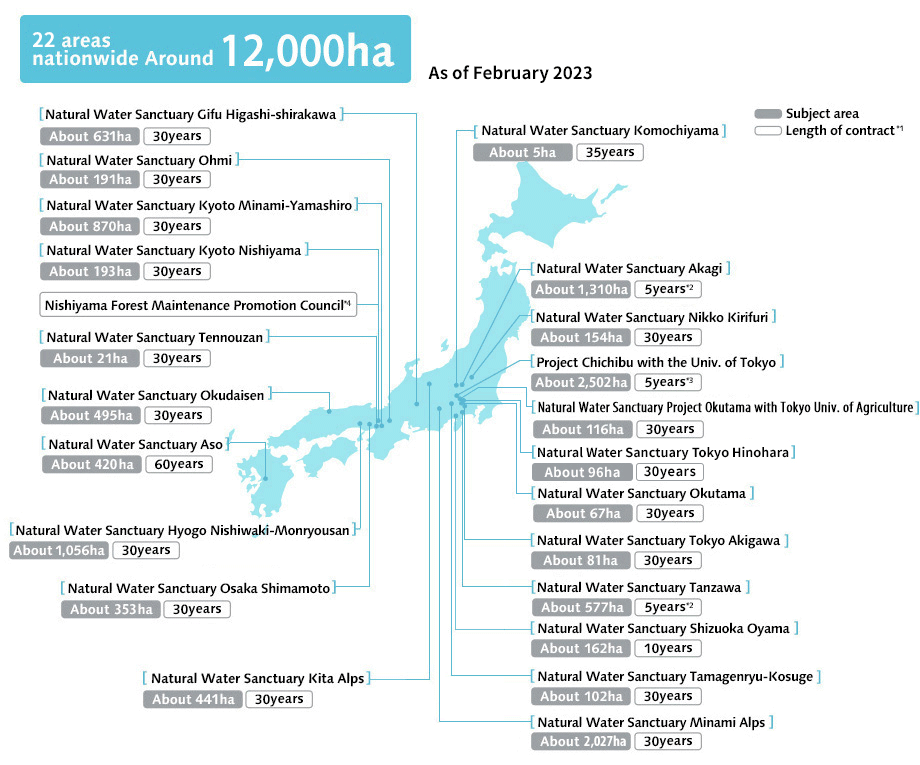
-
*1When there contracts and agreements with different durations, the longest duration is given.
-
*2Planned to conserve for a century.
-
*3Planned to conserve for several decades.
-
*4In Nagaokakyo, Kyoto, we are a member of the Nishiyama forestry development promotion committee and we are cooperating in local forest preservation activities with people in the community. The area of the forests subject to this activity is not counted as part of our total Natural Water Sanctuary area.
Looking at Groundwater -- Comparing simulation models with results from field surveys
One of the main purposes of our Natural Water Sanctuary Initiative to improve the function of forests for recharging water resources.
As a way to evaluate the results, Suntory has been trying to quantitatively evaluate the amount of groundwater recharge using a groundwater flow simulation model since 2006 and is finally approaching a level of accuracy which would allow the model to be used. Through the simulation of groundwater flow, we attempt to simulate where groundwater passes and how long it takes to reach the factory, and combine it with field survey information to deepen understanding of the underground which we normally cannot see. We would like to incorporate these results into the maintenance plan which will lead to more effective cultivation of water source recharge areas.
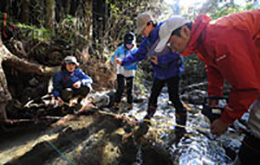
In addition to simulation results, it is also important to combine these results with results based on information gathered in the field during hydrologic surveys, etc. for verification.
Forest Cultivation Which Looks 50 years and 100 Years Into the Future
All forests are different. So what are the special characteristics of each Natural Water Sanctuary as well as the issues that they face?
At first, we engage in activities that follow the RPDCA cycle which includes scientifically-based survey and research (Research), which serves as the foundation, creation of a vision (development plan) suited to each forest (Plan), maintenance work conducted by professionals (Do), verification of results (Check), and consideration of measures for improvement/conducting re-examination (Action).
The areas and fields of investigation and research targeted by Natural Water Sanctuary Initiative are diverse and linked organically. In doing so, cooperation based on the knowledge and skills of experts in various fields and of people in local communities is indispensable. We also use Natural Water Sanctuaries to conduct activities including human resource development support for passing on knowledge and skills (road creation, preventing damage from harmful animals, etc.), Suntory Mizuiku - Education Program for Nature and Water, which allows children to experience the importance of forests since they cultivate water, and The training program of First Hand Experience with Forestry by Suntory employees.
Suntory continues implementation of Natural Water Sanctuary Initiative in order to provide the blessing of nature, something that cannot be replaced, to our children, grandchildren, and future generations to come by first humbly listening to various related issues and work together with local communities to gain knowledge.
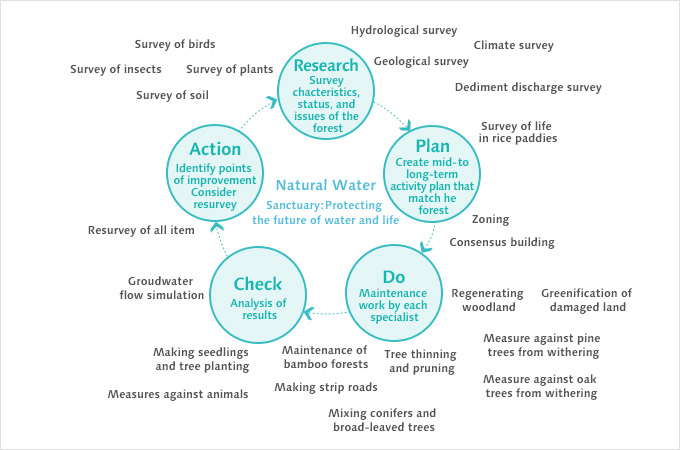
A Healthy Forest is One Full of Life -- Protecting Biodiversity
If there are many different types of plants in a forest, there will be an increase in the types of small animals that eat them, resulting in attracting animals that eat those small animals. In a healthy environment like this, a pyramid formed by various organisms is completed.
In addition to conducting systematic management through continuous ecosystem monitoring of animals, including birds, plants, and insects at Natural Water Sanctuaries, in January 2011 we participated in Biodiversity Declaration Promotion Partners initiated by Keidanren (Japan Business Federation) and are taking the initiative to create a society rich in biodiversity.
In 2022, we published the Suntory Natural Water Forest Biodiversity "Restoration" Report. This report consists of two sections, a "Facts & Data" section that summarizes various issues facing Japanese forests and an "Actions" section which provides simple explanations and examples of activities taken to address these issues in "Suntory Natural Water Forests."
Suntory Natural Water Forest Biodiversity Restoration Report
-
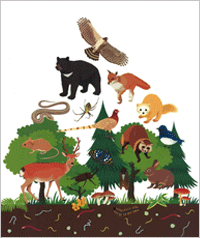
Biodiversity Pyramid of a Forest:
Protecting the soil and vegetation
leads to the protection of the entire ecosystem. -
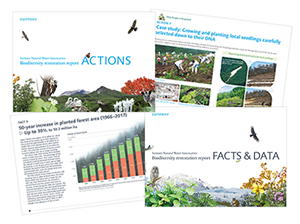
Suntory Natural Water Forest Biodiversity
Restoration Report Published
Biodiversity in a Natural Water Sanctuary from a Bird's Perspective
The plant and animal life living in the forest will change if the typical functions of the forest can be revitalized. Focusing on wild birds, which are said to serve as a barometer of a given environment, we conduct wild bird surveys by specialists in the Natural Water Sanctuaries every year based on the idea that it is possible to comprehensively grasp the changes in the entire ecosystem that supports them.
In addition, We have been promoting the project of nest building and rearing of chicks by eagles and hawks at all the Natural Water Sanctuaries in Japan with the purpose of advancing the development of a forest rich with biodiversity by taking the perspective of natural wild birds in the Natural Water Sanctuaries.
Becoming More Familiar with Natural Water Sanctuaries
Ikurinzai - Timber From Cultivated Forests Project
It is necessary to cut down trees in order to keep a forest healthy. The Suntory Group calls wood material made from Natural Water Sanctuary Initiative to nurture sustainable water and forests "Ikurinzai - Timber from cultivated forests, carefully using all the conifer and broad-leaved trees removed during tree cutting, road creation, and other activities.
Case Examples of Timber Utilization Inside and Outside of the Company
-
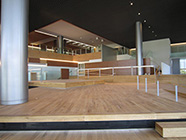
Research Location:
Timber used to create the entrance (flooring, etc.)
of Suntory World Research Center -
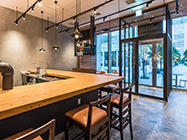
All table tops at PRONTO mbs Tamachi shop.
Natural Water Sanctuary Forum
Based on the goal of "Creating Forests Which Nurture Water and Life," specialists in a variety of fields who provide coaching and collaborate in Natural Water Sanctuary Initiative are invited the form which serves as an opportunity to share the newest expertise and policies for future activities. The forum was held nine times from 2011 to 2019.
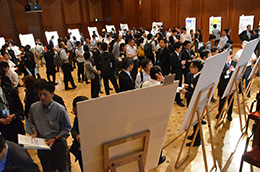
A poster session where guests can ask lecturers questions and exchange opinions
Training Program for Employees
Many group employees and their families have volunteered for the forest stewardship program in Natural Water Sanctuaries up to 2013. Since 2014, so that each employee experiences and understands the values of our corporate philosophy "To Create Harmony with People and Nature," a total of about 7,400 people (including about 800 volunteers) participated in the First Hand Experience with Forestry as a training program for Suntory Group company employees, mainly current employees of Suntory Holdings and Suntory Beverage & Food.
-
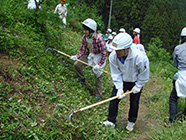
Employees cutting undergrowth
at a Natural Water Sanctuary -
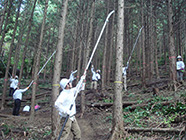
Employees pruning trees
at a Natural Water Sanctuary
University of Tokyo "The Wisdom of Water" (Suntory) Corporate Sponsored Research Program
Suntory Holdings established the University of Tokyo "The Wisdom of Water" (Suntory) Corporate Sponsored Research Program in April 2008, and it has held this research program for five years. By cultivating more social interest in water, we are engaging in the various activities below with the aim of contributing to the education of research in academic fields while promoting solutions of water issues as well as developing a rich water environment.
Activity Case Examples
-
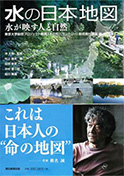
"Water Map of Japan"
-
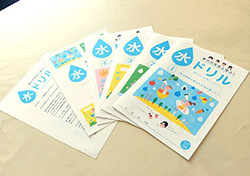
"Water Drill"
educational contents for elementary students -

The Wisdom of Water and
Scientific Study of Forests and Water
websites
Bird Conservation Activities
Wild birds are said to be an indicator of natural environment. Understanding that the wild bird protection is linked to the protection of humans and the natural environment, we began our involvement in bird conservation activities in 1973.
History of Suntory Bird Conservation Activities
| Year of activity | Content |
|---|---|
| 1973 |
|
| 1989 |
|
| 1990 |
|
| 1993 |
|
| 2006 |
|
| 2014 |
|
| 2016 |
|
| 2018 |
|
| 2021 |
|
| 2022 |
|
-
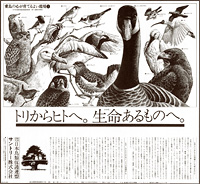
1st Save the Birds! Campaign newspaper ad
-
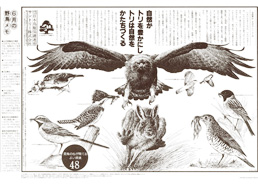
The Suntory Fund for Bird Conservation
As one of the activities commemorating the 90th anniversary of our founding, we enhanced bird conservation activities with the establishment of the Suntory Fund for Bird Conservation in 1989. As this initiative is designated to promote global environmental conservation through the protection of wild birds, funds are granted for bird protection activities both in Japan and overseas.
Over the 33 years since becoming a charitable trust in 1990, the Foundation has granted total of ¥623 million to 472 organizations up to 2022, making great achievements. 2020 presentation ceremony has been canceled to avoid risk of covid-19. In 2021 and 2022, the presentation ceremony was held online.
-
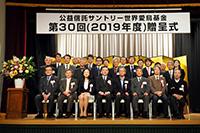
The 30th Fund Granting Ceremony of
Public Trust Suntory Fund for Bird
Conservation -
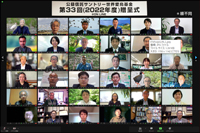
The 33th Fund Granting Online Ceremony of
Public Trust Suntory Fund for Bird
Conservation -
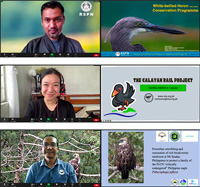
Presentation of activities of
foreign grantees who participated
online in the presentation ceremony
The Hakushu Distillery Bird Sanctuary
We started bird conservation activities in 1973, and in the same year, as the first private company, we opened a wild bird sanctuary in the Hakushu Distillery in Yamanashi Prefecture.
Surrounded by rich forests and many clear streams, the Hakushu Distillery is a relay point of migration for wild birds. In the bird sanctuary, Suntory periodically conducts bird research and, together with the local people, engages in forest preservation activities to maintain an environment by various activities including nest box hanging and other activities.
The Hakushu Distillery Bird Sanctuary
-
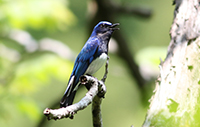
Blue-and-white flycatcher
-

Ural Owl
-
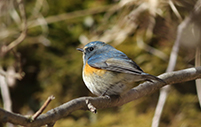
Red-flanked bluetail
-
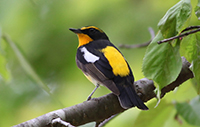
Narcissus Flycatcher
-
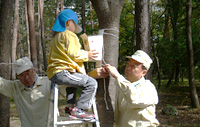
Hanging boxes in the Bird Sanctuary
Communication
We are putting out a broad range of information through our websites and other tools to familiarize more people with these wild birds. On the Japanese Bird Encyclopedia website, anyone can enjoy learning about over 200 species of wild birds through illustrations with explanations, bird calls, and pictures.
The Bird Watching that Starts Today website recommends bird watching spots nearby while introducing hints and points of caution when observing wild birds. These websites can even be enjoyed while out and about on a smartphone.
We are also creating leaflets on how to easily distinguish the birds around you to help in bird watching and leaflets about how to easily make feeders, birdbaths and nest to encourage birds into your area.
-
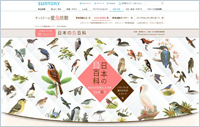
Japanese Bird Encyclopedia website
-

The Bird Watching that Starts Today
website -
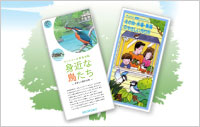
Save the Birds Activity leaflets
Suntory Mizuiku - Education Program for Nature and Water
We are implementing Suntory Mizuiku - Education Program for Nature and Water to pass down precious natural environment to the next generation.
Suntory Mizuiku - Education Program for Nature and Water
Suntory Mizuiku - Education Program for Nature and Water celebrates its 19th year in 2022. Suntory Mizuiku - Education Program for Nature and Water is a program unique to Suntory designed for the next generation to realize the beauty of nature and importance of water and the forests that nurture the groundwater and to think about what they can do to ensure there is water in the future. The program centers on two activities: Outdoor School of Forest and Water and Teaching Program at Schools.It started online in 2020.
-
*Sponsor: Ministry of the Environment, Ministry of Education, Culture, Sports, Science and Technology, etc.
Outdoor School of Forest and Water
This hands-on nature program geared to elementary school students from grades three through six and their parents or guardians is held in the home regions of (Mineral Water) Suntory Tennensui. Participants experience for themselves the importance of water and of the forests that produce it amid the great outdoors at Hakushu (Yamanashi prefecture), Okudaisen (Tottori prefecture), and Aso (Kumamoto prefecture). Around 28,900 students and their parents took part in the program since it began in 2004 through 2021. We opened a remote school in 2020.
The Outdoor School of Forest and Water staff conduct the program together with expert instructors that play active role locally in environmental education.
Total number of participants at the Suntory Mizuiku - Natural Water Education Program Outdoor School of Forest and Water
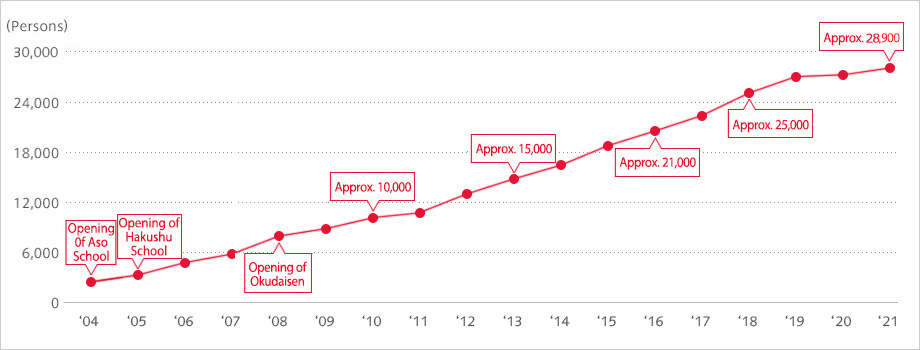
Outdoor School of Forest and Water
Teaching Program at Schools
We offer study programs for students in grades 4 and 5 in elementary schools together with their teachers. We believe we can make a difference by teaching the cycle and importance of nature through videos and experiments so that together we can pass down water to future generations. The number of students participating in these programs are roughly 181,200 at approximately 2,364 schools as of 2021. Online classes have also started in 2020, which enable any schools to take part in all over Japan.
Total number of participants for Teaching Program at Schools
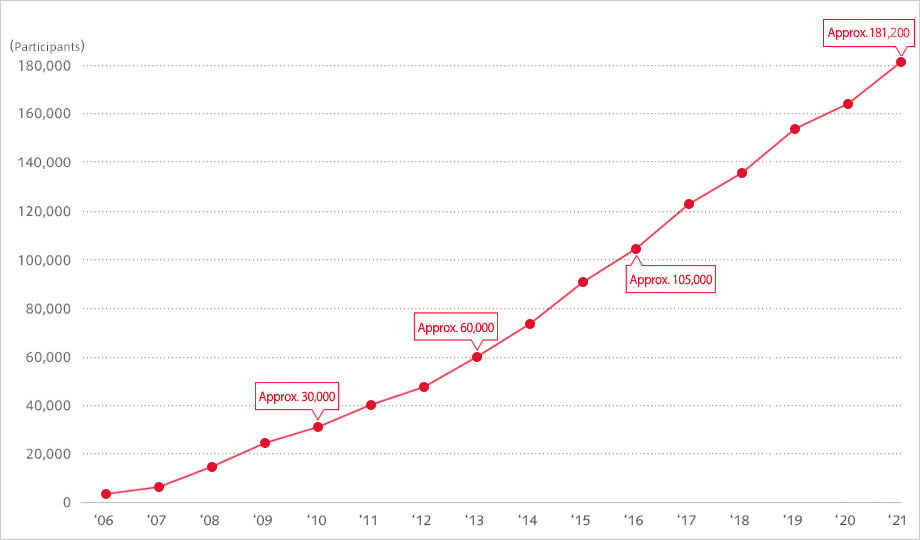
Teaching about Water at Schools
Suntory Mizuiku - Natural Water Education Program Website
The Suntory Mizuiku - Natural Water Education Program website is a place to have fun and learn about water. The website includes detailed information about the Outdoor School of Forest and Water and the Teaching Program at Schools programs in addition to kids pages such as the encyclopedia that brings together independent water research and comprehensive knowledge about water.
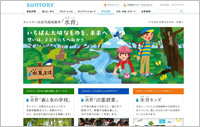
Suntory Mizuiku - Natural Water Education Program Website
Expanding Suntory Mizuiku - Education Program for Nature and Water on a Global Level
With the expansion of Suntory Group's business activities internationally, we have also expanded Suntory Mizuiku - Education Program for Nature and Water overseas with the hope of promoting environmental activities globally.
Vietnam
We started the Vietnam Version of Suntory Mizuiku - Education Program for Nature and Water from March 2015, marking our first Suntory Mizuiku effort overseas.
We developed original education materials in collaboration with our group company, Suntory Pepsico Vietnam Beverage and international NGOs such as Live and Learn, started collaboration with the Central Council of Ho Minh Young Pioneer Organization as well as the Vietnam National Union of Students from 2017, and have been conducting classes for third and fourth grade children to learn about the importance of water, sanitary management, and the importance of preserving water resources. We are also expanding teaching classes in each region by dispatching qualified Mizuiku instructors as part of a summer program. Starting in Hanoi City, classes are also taught in Ho Chi Min City and Bac Ninh, Ben Tre, Quang Nam, Lang Son, Ha Giang, Dong Nai, Thai Nguyen, Da Nang, Tra Vinh , Binh Thuan, Cao Bang, Thai Bing Provinces and Hai Phong City. As of the end of 2021, approximately 81,000
children have participated in the program since its inception.
In addition, we are contributing to the installation of toilets and washrooms at elementary schools to improve sanitary environment of children.
This activity was created to contribute to Target 6.B of Sustainable Development Goal 6 "Ensure access to water and sanitation for all."
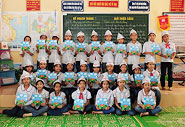
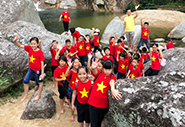
Suntory Mizuiku - Education Program for Nature and Water in Vietnam
Thailand
From July 2019, we started Suntory Mizuiku - Education Program for Nature and Water in Thailand, the second foreign country in addition to Vietnam to serve as a program target location.
Through the collaboration of our group company Suntory PepsiCo Beverage Thailand and a local NGO, we implemented an educational program for fourth, fifth, and sixth grade children from Saraburi Province and Rayong Province, where Suntory PepsiCo Beverage Thailand plants are located, and Chiang Mai Province, which possesses the most water resources in Thailand. In 2021, the water education project at elementary schools in Ayutthaya, Pathumthani, Nakornpathom Provinces and Bangkok has been launched. Approximately 11,000 persons have participated in the program as of the end of 2021. It is an original program which teaches children about the importance of water, the importance of protecting water resources, and similar matters.
We also began a project to prevent sediment based erosion by slowing the currents of streams in northern Chiang Mai Province, installed small weirs to support permeation of underground water, planted trees to prevent soil from flowing into the streams.
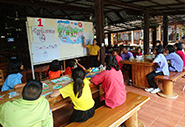
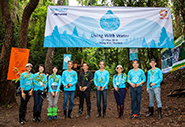
Suntory Mizuiku - Education Program for Nature and Water in Thailand
Indonesia
We started the Indonesia Version of Suntory Mizuiku - Education Program for Nature and Water in July 2019.
Collaborating with our group company Suntory Garuda Beverage, a local foundation, and a local NGO, we implemented an educational program for elementary school children in Gowa (South Sulawesi Province), Banjarbaru (South Kalimantan Province), Sidoarjo (East Java Province), Tangerang (Banten Province), Jakarta (the capital city) and Bogor (West Java Province). Approximately 14,000 persons have participated in the program as of the end of 2021.
As in Vietnam, we teach about the importance of water, healthy water cycle, and the importance of preserving water resources through an original learning program. The program provides basic knowledge about water, addresses water pollution and how to eliminate it, and explores water preservation efforts that children can contribute to on an individual level. This contributes to improving children's awareness about environment in Indonesia.
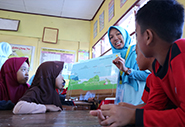
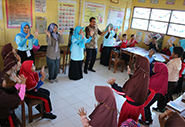
Suntory Mizuiku - Education Program for Nature and Water in Indonesia
France
In July 2020, Suntory Beverage & Food France established a workshop-based water education program for elementary school students in partnership with Grand Parc Miribel Jonage, a nature park located near its Meyzieu Plant. The program includes content on the role forests have in cultivating water, experiments to show how rainwater becomes underground water, and more. It was developed as part of the partnership Suntory Beverage & Food France began with Grand Parc Miribel Jonage in 2017 for water conservancy.
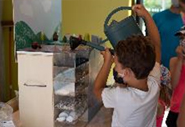
Workshop-based water education program in France
Spain
From May 2022, we started Suntory Mizuiku - Education Program for Nature and Water in Spain.
Through the collaboration of our group company Suntory Beverage & Food Spain, a local NPO, and local experts, we implemented an educational program for primary school students in the province of Toledo. The field activities are carried out in the natural environment of the Guajaraz reservoir in the vicinity of Toledo, where the main factory of Suntory Beverage & Food Spain is based and source their water from. The program teaches students the importance of water such as by deepening their understanding on the natural water cycle and how it relates to their daily lives, how to use water responsibly, and the relationship between water and biodiversity, as well as provide training and ideas on how to preserve and improve the quality and quantity of water in the future.
Water Initiatives Worldwide
The Suntory Group businesses are supported and realized by precious global resources such as water. The global environment which holds the blessings of water and nature is a vital foundation of our businesses. We actively strive to coexist with the natural environment worldwide as we expand these businesses to pass down a sustainable society to the next generation. The Suntory Group will continue to engage in various initiatives in the future with the goal of becoming a global pioneer of environmental conservation.
Environmental Conservation Activities to Cultivate Water
Suntory Beverage & Food Europe
In France, Suntory Beverage & Food Europe entered into a 20-year partnership for the conservation of water resources in 2017 with Grand Parc Miribel Jonage, a nature park located next to the Meyzieu Plant. This partnership conducts conservation activities in the forest spanning the Grand Parc Miribel Jonage and supports educational programs for children, in addition to protecting water resources and the natural environment near the plant as well as promoting cultivation activities with the local community.
In Spain, Suntory Beverage & Food Europe engaged in ecosystem conservation activities with the cooperation of the local community in the hope of revitalizing the ecosystem in and around the Júcar river near its plant in Carcagente.
Access to Safe Water
Suntory Beverage & Food Asia Pacific
In Vietnam, Suntory Beverage & Food Asia Pacific has been contributing to repairs and installations of toilets and washrooms mainly at schools taking part in the Suntory Mizuiku since 2015 to improve the sanitary environment for children.
In 2019, sediment based erosion was prevented by slowing the currents of streams in northern Chiang Mai Province, small weirs to support permeation of groundwater were installed, trees were planted to prevent soil from flowing into the streams, and other water resource preservation activities were carried out.
In Nairobi, Kenya, Suntory engages in activities to supply clean and safe drinking water to schools through the Kangemi Resource Centre, which supports the education of the local community and addresses water shortages.
Endorsing The CEO Water Mandate
The Suntory group which Suntory Beverage and Food belongs to endorsed The CEO Water Mandate global platform to address water resource issues, which is a United Nations Global Compact initiative to support the prevalence, practice and informational disclosure of water sustainable at companies.

Achieving the AWS Certification for Water Stewardship
First in Japan to earn International Certification for Water Stewardship, the Alliance for Water Stewardship (AWS)
Suntory has achieved the first AWS International Certification in Japan for the Suntory Okudaisen Bunanomori Water Plant (Tottori Prefecture) in 2018 and then for Kyushu Kumamoto Plant (Kumamoto Prefecture) in 2019, followed by The Minami Alps Hakushu Water Plant in 2021. This page introduces its significance.
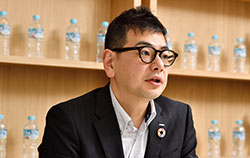
Suntory Holdings Limited
General Manager, Sustainability Management Division
Harumichi Seta
Why Suntory is promoting the AWS
Suntory has been providing new values to people through its products and services to enrich their lives, which is the core of our business. Water is the most critical resource required for us to continue offering value to the customers and the essential resource for local communities and the ecosystem. Furthermore, water is a local resource that circulates depending on the local climate and geographical conditions. Evaporated sea water becomes clouds, rain down to become part of a river or groundwater, and then join larger rivers and back to the sea. This geographical zone is called a catchment. The water we withdraw to produce our products is part of the water cycle, connected to the more significant flow of the catchment like rivers or underground aquifers. Suntory regards itself as a part of the natural water cycle and promotes water stewardship activities in catchments around its plants to preserve the healthy water cycle.
Water Cycle in a Catchment
Water stewardship indicates the responsible management and planning of water resources at the catchment level in collaboration with key stakeholders such as governmental agencies and the local community, in addition to managing water within our own plants. The initiative aims to promote the use of water that is socially and culturally equitable, environmentally sustainable, and economically beneficial throughout the entire catchment. Suntory conduct initiatives to contribute to a healthy water cycle in the watersheds based on the Suntory Group’s "Sustainable Water Philosophy," which has four pillars—understanding the natural water cycle, promoting environmentally conscious water use, conserving watersheds, and engaging with the local community. In addition to using water carefully through continuous water-saving activities and wastewater management at plants, Suntory established Institute for Water Science in 2003 to conduct hydrologic studies and scientifically understand the water cycle in watersheds around our plants. In the same year, the Natural Water Sanctuary Initiative began in Kyushu Kumamoto Plant to conserve the water source have expanded the area to 22 locations totaling about 12,000 ha in Japan and achieved the target of cultivating more than twice the amount of water withdrawn by our plants. We continue to realize our vision for the next 50 and 100 years with the support of experts in various fields and residents and to create a forest that nurture groundwater for the watersheds.
Moreover, we conduct the Suntory Mizuiku - Education Program for Nature and Water at the Natural Water Sanctuaries and local elementary schools near Tennensui Water Plants and cooperate with local government agencies and the community to monitor the catchments’ groundwater level and water resources. Furthermore, we implement forest maintenance and paddy impounding to recharge groundwater and disseminate attractiveness to vitalize local communities under signed partnership agreements with local government agencies. Suntory became the first company to earn the internationally respected standard for water stewardship, the AWS Certification, to continuously deepen such integrated water resource management itself along the "Sustainable Water Philosophy."
Integrated Water Resource Management
About AWS
The Alliance for Water Stewardship (AWS) is an organization globally promoting water sustainability established by NGOs, such as the World Wildlife Fund (WWF), The Nature Conservancy (TNC), and companies. The AWS Certification is an international certificate for sustainable water use targeting plants globally and aims to promote water stewardship.
For the certificate audit of Okudaisen Bunanomori Water Plant, Suntory Kyushu Kumamoto Plant, and The Minami Alps Hakushu Water Plant, the assessment body were highly evaluated our integrated water resource management; understanding of the water balance in the catchment around the plants, in line with the Suntory Group's "Sustainable Water Philosophy," water source conservation based on scientific data, water saving and water quality management initiatives at plants, our work with stakeholders, and appropriate disclosure.
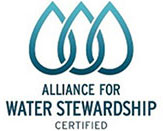
About the Partnership Agreement
Suntory Holdings received the request from the AWS to take leadership as a company that leads the promotion of water sustainability in Japan. Endorsing its purpose, we signed a partnership agreement with AWS Asia Pacific in February 2021. We also became the first company with AWS membership in Japan.
As the initiatives under the partnership agreement, we supervised the Japanese edition of the AWS International Standards issued in August 2021. We also introduced the certification of the AWS for Suntory Kyushu Kumamoto Plant through a case study etc., of water source conservation activities by winter paddy impounding at the 4th Asia Pacifica Summit held in April 2022, in cooperation with the Water Stewardship Asia Pacific. Suntory will advocate the importance of water resource management by the private sector.
Acquisition of AWS Certification by Suntory
2018
<First in Japan>
Suntory Okudaisen Bunanomori Water Plant
Achieved the AWS Certification
AWS Activity Report
(Suntory Okudaisen Bunanomori Water Plant)
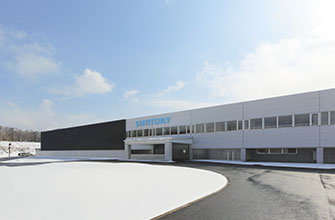
2019
Suntory Kyushu Kumamoto Plant
Achieved the AWS Certification
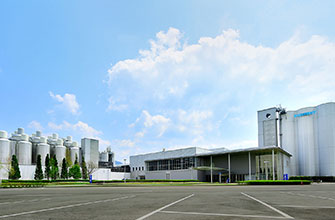
2021
<First in Japan>
Signed partnership agreement with AWS Asia Pacific
<First in Japan>
Member of the AWS Supporting Companies
Suntory Minami Alps Hakushu Water Plant
Achieved the AWS Certification
AWS Activity Report
(Suntory Minami Alps Hakushu Water Plant)
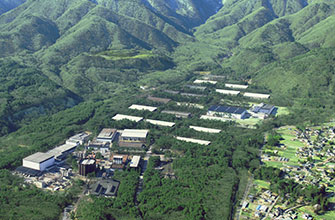
2023
<First in Japan>
Suntory Kyushu Kumamoto Plant
Achieved the AWS "Platinum" Certification

We will continue to further engage in AWS activities
AWS Activity Report 2021
AWS Activity Report (Suntory Okudaisen Bunanomori Water Plant)
AWS Activity Report (Suntory Kyushu Kumamoto Plant)
AWS Activity Report (Suntory Minami Alps Hakushu Water Plant)
Sustainability
Water & CO2
- Sustainable Water Philosophy
- Water Sustainability
- Enhanced 3Rs for Water to Reduce Water Use
- Water Risk Assessment
- Natural Water Sanctuaries (Water Resource Cultivation/ Preserving Biodiversity)
- Bird Conservation Activities
- Suntory Mizuiku - Education Program for Nature and Water
- Water Initiatives Worldwide
- Endorsing The CEO Water Mandate
- Achieving the AWS Certification for Water Stewardship
Raw Ingredients
Containers and Packaging
Human Rights
Health
Activities of Overseas Group Companies
Data
- Environmental Data
- Water
- Greenhouse Gas (GHG)
- Plastic
- By-Products and Waste Generation
